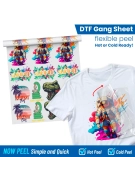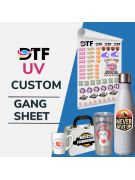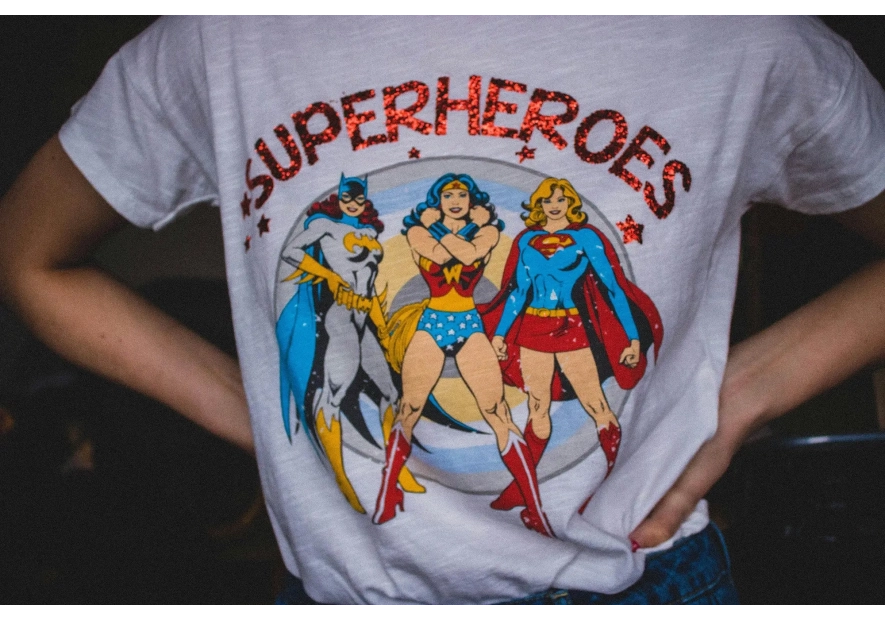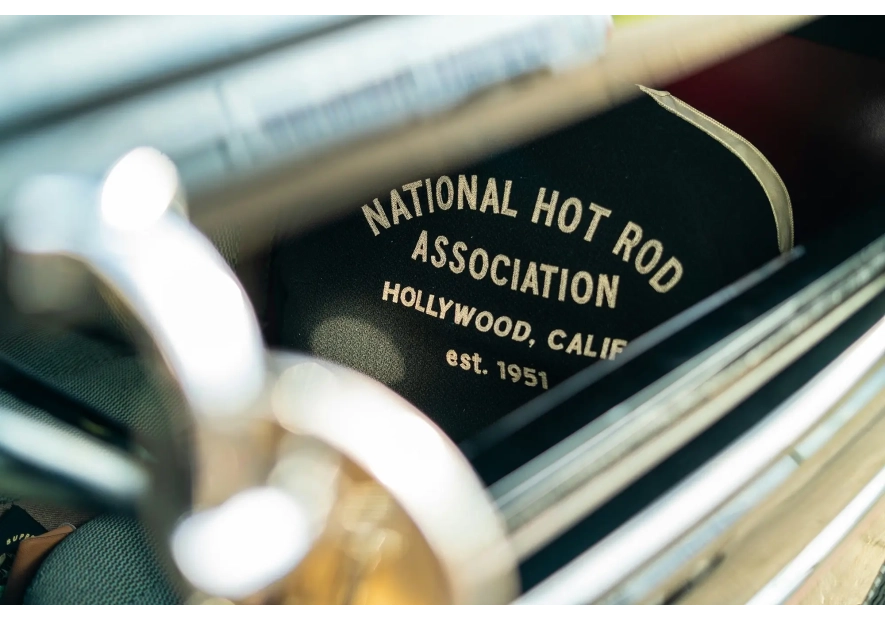Top 10 Most Asked DTF Transfers Questions

What Does DTF Stand For?
DTF stands for "Direct to Film" in the context of DTF transfers. It refers to a printing method where designs are directly printed onto a transfer film using specialized ink and then transferred onto garments or other surfaces using a heat press.
DTF transfers are known for their vibrant colors, durability, and versatility, making them a popular choice for apparel decoration and other printing applications.
What Are DTF Transfers?
DTF transfers, short for "Direct to Film" transfers, are a modern and innovative printing method used to create high-quality, vibrant designs for apparel decoration and other surfaces. In the DTF process, designs are directly printed onto a specialized transfer film using pigmented ink. Once the designs are printed on the film, an adhesive powder is applied, which adheres to the ink, creating a transferable layer.
The printed design with the adhesive powder is then heat pressed onto the fabric or surface, where the ink and adhesive fuse together, permanently bonding the design to the material. The excess adhesive is removed during the heat press process, leaving behind a vibrant, detailed, and durable design on the garment or surface.
DTF transfers offer several advantages, including excellent color reproduction, versatility with different fabric types, and the ability to print intricate designs and multi-color prints with ease. They are ideal for various applications, such as custom apparel, promotional items, and personalized products.
DTF transfers have gained popularity in the printing industry due to their efficiency, cost-effectiveness, and exceptional results, making them a favorite choice for businesses and DIY enthusiasts alike.
What Surfaces Can DTF Transfers Be Applied To?
DTF transfers can be applied to a variety of surfaces, including:
Cotton Fabrics: DTF transfers adhere well to cotton fabrics, making them a popular choice for printing on t-shirts, sweatshirts, and other cotton-based apparel.
Polyester Fabrics: DTF transfers work effectively on polyester fabrics, providing vibrant and long-lasting prints for sportswear, activewear, and sublimation-coated polyester materials.
Blends: DTF transfers are compatible with fabric blends that include a combination of cotton and polyester or other materials.
Denim: DTF transfers can be successfully applied to denim fabrics, adding unique and detailed designs to jeans, jackets, and other denim apparel.
Canvas: DTF transfers are suitable for canvas materials, allowing you to create custom art prints and personalized canvas products.
Performance Fabrics: DTF transfers can be used on performance fabrics like moisture-wicking materials commonly used in athletic apparel.
Bags and Accessories: DTF transfers can be applied to various accessories, such as bags, caps, and hats, to add personalized designs.
Promotional Items: DTF transfers can be used to print on promotional items like mugs, mousepads, and more, offering versatility in product customization.
Upholstery: DTF transfers can be applied to certain types of upholstery fabrics, enabling unique and custom designs for furniture and interior decor.
It's important to note that the surface compatibility of DTF transfers may vary based on the specific transfer film and ink used. For the best results, it is recommended to test the DTF transfer on the target surface before large-scale production. Overall, DTF transfers offer a versatile and efficient solution for adding vibrant and detailed designs to a wide range of surfaces.
How Durable Are DTF Transfers?
DTF transfers are known for their exceptional durability, making them a reliable and long-lasting option for apparel decoration and other printing applications. The durability of DTF transfers is attributed to several factors:
Wash Resistance: DTF transfers exhibit excellent wash resistance, meaning the prints remain vibrant and intact even after multiple wash cycles. When applied correctly and with the right temperature and pressure during the heat press process, DTF transfers bond securely to the fabric, ensuring the design withstands regular laundering.
Color Fastness: The pigmented ink used in DTF transfers provides excellent color fastness. This means the colors remain vivid and do not fade significantly over time, ensuring the design retains its original brilliance.
Flexibility: DTF transfers are designed to maintain their integrity even on stretchy fabrics and garments subject to frequent movement. The ink and adhesive bond to the fabric, allowing the design to stretch and move with the material without cracking or peeling.
Resistance to Cracking and Peeling: When applied correctly and with the appropriate heat press settings, DTF transfers are resistant to cracking and peeling, ensuring the design remains seamless and intact.
Durability in Various Environments: DTF transfers exhibit robust performance in various environmental conditions, including exposure to sunlight, moisture, and frequent wear, making them suitable for both indoor and outdoor applications.
Versatility: DTF transfers can be applied to different fabric types, including cotton, polyester, blends, and more, ensuring their durability across a wide range of materials.
It is essential to follow proper application guidelines and use high-quality transfer films and ink to ensure the durability of DTF transfers. By adhering to recommended printing techniques and post-printing care, you can ensure that your DTF transfers maintain their durability and vibrant appearance for an extended period, meeting the high standards expected in the printing industry.
Can DTF Transfers Be Used On Dark-Colored Fabrics?
Yes, DTF transfers can be used on dark-colored fabrics. One of the advantages of DTF transfers is their versatility, allowing them to work effectively on both light-colored and dark-colored fabrics. Unlike some other printing methods, DTF transfers can produce vibrant and opaque designs on dark fabrics without compromising the design's color intensity and clarity.
To achieve optimal results when using DTF transfers on dark fabrics, a white base layer is typically applied before printing the colored design. This white base layer acts as a primer, creating a solid foundation for the colored ink to adhere to and ensuring that the design stands out vividly on the dark fabric.
The process of printing a white base layer before applying the colored ink is known as "white underbase" or "white base printing." The white underbase ensures that the colors appear vibrant and true to their original shades, even on dark fabrics.
When working with DTF transfers for dark-colored fabrics, it is crucial to use high-quality transfer films and inks to achieve the best results. Proper application techniques, such as setting the correct temperature and pressure during the heat press process, also play a crucial role in ensuring the durability and appearance of the DTF transfers on dark-colored fabrics.
Overall, DTF transfers provide an excellent solution for printing on both light and dark fabrics, offering exceptional color reproduction and durability regardless of the fabric's color.
Are DTF Transfers Environmentally Friendly?
DTF transfers can be considered more environmentally friendly compared to some other printing methods. Here are some reasons why:
Waterless Printing: DTF transfers are a waterless printing method, which means they do not require the extensive use of water during the printing process. This reduces water consumption and the environmental impact associated with water-based printing methods.
Eco-Friendly Inks: Many DTF transfer companies, including DTF Transfers Now, use eco-friendly and non-toxic inks. These inks have a lower environmental impact and are safer for both users and the environment.
Reduced Waste: DTF transfers are designed to be printed on gang sheets, which allows for efficient use of the printable area and minimizes material waste. The ability to arrange multiple designs on a single sheet reduces the need for excess film and reduces overall waste.
Energy Efficiency: DTF transfers require less energy during the heat press process compared to other printing methods like screen printing or sublimation. This makes DTF transfers more energy-efficient and reduces carbon emissions.
Versatility and Durability: DTF transfers are known for their durability, which means they have a longer lifespan than some other printed products. Longer-lasting prints reduce the need for frequent reprints and replacements, resulting in less waste.
While DTF transfers offer certain environmental benefits, it's essential to acknowledge that no printing method is entirely free from environmental impact. The overall environmental friendliness of DTF transfers can also be influenced by factors like the sourcing of materials, recycling practices, and the disposal of unused film and transfer waste.
To enhance the eco-friendliness of DTF transfers, printing businesses and consumers can further prioritize sustainable practices, such as recycling and responsible disposal, using eco-friendly products, and continuously seeking ways to minimize waste throughout the printing process.
Can DTF Transfers Be Customized With Different Designs?
Yes, DTF transfers can be fully customized with different designs. One of the significant advantages of DTF transfers is their ability to accommodate various designs on a single gang sheet, making them highly customizable and versatile.
With DTF transfers, you can print multiple designs on the same sheet, allowing you to fulfill various orders with ease and efficiency. This is especially beneficial for printing businesses that deal with diverse customer requests or small quantities of different designs.
The process of customizing DTF transfers with different designs typically involves arranging the artwork on the gang sheet using specialized software or tools. You can adjust the size, placement, and orientation of each design to create a layout that optimizes the printable area while ensuring the designs fit within the sheet's dimensions.
Customizing DTF transfers with different designs allows for personalized and unique printing options. Whether you need to print a series of individual graphics or create themed sets of designs, DTF transfers provide the flexibility to meet your specific requirements.
Additionally, DTF transfers can incorporate different colors and intricate details, allowing for a wide range of design possibilities. From custom apparel and accessories to promotional products and personalized gifts, DTF transfers offer a versatile and customizable solution for various printing applications.
Are DTF Transfers Waterproof?
DTF transfers are not inherently waterproof, but their water resistance can vary depending on the transfer film and ink used in the printing process. While DTF transfers are known for their durability and wash resistance, they may not be entirely impervious to water in all cases.
The water resistance of DTF transfers is primarily determined by the quality of the transfer film and ink, as well as the heat press application process. High-quality DTF transfers, when applied correctly, can withstand exposure to light water splashes and mild moisture without significant damage to the design.
However, prolonged or intense exposure to water, such as submerging the printed garment or item in water, may cause the DTF transfer to degrade over time. To ensure the best water resistance, it's essential to use reputable DTF transfer materials and adhere to recommended printing and heat press guidelines.
For specific applications requiring enhanced water resistance, some manufacturers offer specialized DTF transfer products with additional protective coatings. These coatings can provide an extra layer of protection against water, increasing the longevity of the printed design.
If you require DTF transfers with a higher degree of water resistance for specific applications, it is recommended to consult with your DTF transfer supplier or manufacturer to find the most suitable transfer film and ink options for your needs.
Can DTF Transfers Be Used For Both Small And Large-Scale Production?
Yes, DTF transfers can be used for both small and large-scale production. One of the key advantages of DTF transfers is their ability to accommodate various production quantities, making them suitable for businesses and individuals with different printing needs.
For Small-Scale Production:
DTF transfers are an excellent choice for small-scale production due to their flexibility and cost-effectiveness. Whether you need to print a few custom designs for personal use, small batches for a boutique shop, or limited-edition items, DTF transfers allow you to fulfill smaller orders efficiently. The ability to customize designs on a gang sheet enables you to print multiple different designs in one print run, saving time and resources.
For Large-Scale Production:
DTF transfers are equally suitable for large-scale production. When you have high-volume orders or need to print large quantities of the same design, DTF transfers can deliver consistent and efficient results. The fast turnaround time of DTF transfers and their ability to print multiple designs on a single gang sheet make them a practical option for fulfilling large orders within a short timeframe.
Additionally, DTF transfers are versatile and can be used for a wide range of applications, from apparel decoration to promotional products, allowing businesses to cater to various markets and industries.
Whether you are a small business owner, a printing professional, or a DIY enthusiast, DTF transfers provide the flexibility and scalability to meet your production requirements, regardless of the order size.
How Long Do DTF Transfers Last On Garments?
The longevity of DTF transfers on garments can vary depending on several factors, including the quality of materials used, the printing process, and the care given to the printed garments. When applied correctly and with proper care, DTF transfers can have excellent durability and lasting power on fabrics.
In general, well-made and properly applied DTF transfers can last for a long time, even through multiple wash cycles and regular wear. DTF transfers are known for their wash resistance, which means the printed designs should remain vibrant and intact after numerous washes.
To ensure the longevity of DTF transfers on garments, consider the following tips:
Use High-Quality DTF Transfers: Opt for DTF transfers from reputable manufacturers that use high-quality transfer film and ink. Quality materials contribute to the overall durability of the printed designs.
Follow Recommended Printing Guidelines: Adhere to the recommended printing settings, including temperature, pressure, and time, during the heat press process. Proper application ensures a strong bond between the transfer and the fabric.
Choose Appropriate Fabrics: DTF transfers work best on fabrics like cotton and polyester blends. Choose fabrics that are compatible with DTF printing to enhance the transfer's longevity.
Wash with Care: Follow the garment's care instructions and use mild detergents. Avoid using harsh chemicals, bleach, or abrasive washing techniques that could damage the transfer.
Avoid High Heat and Direct Ironing: When ironing the printed area, avoid applying direct heat on the transfer. Use a protective cloth between the iron and the transfer.
With proper care, DTF transfers can maintain their vibrancy and appearance for a long time, making them an excellent choice for durable and high-quality apparel decoration.





Leave a comment